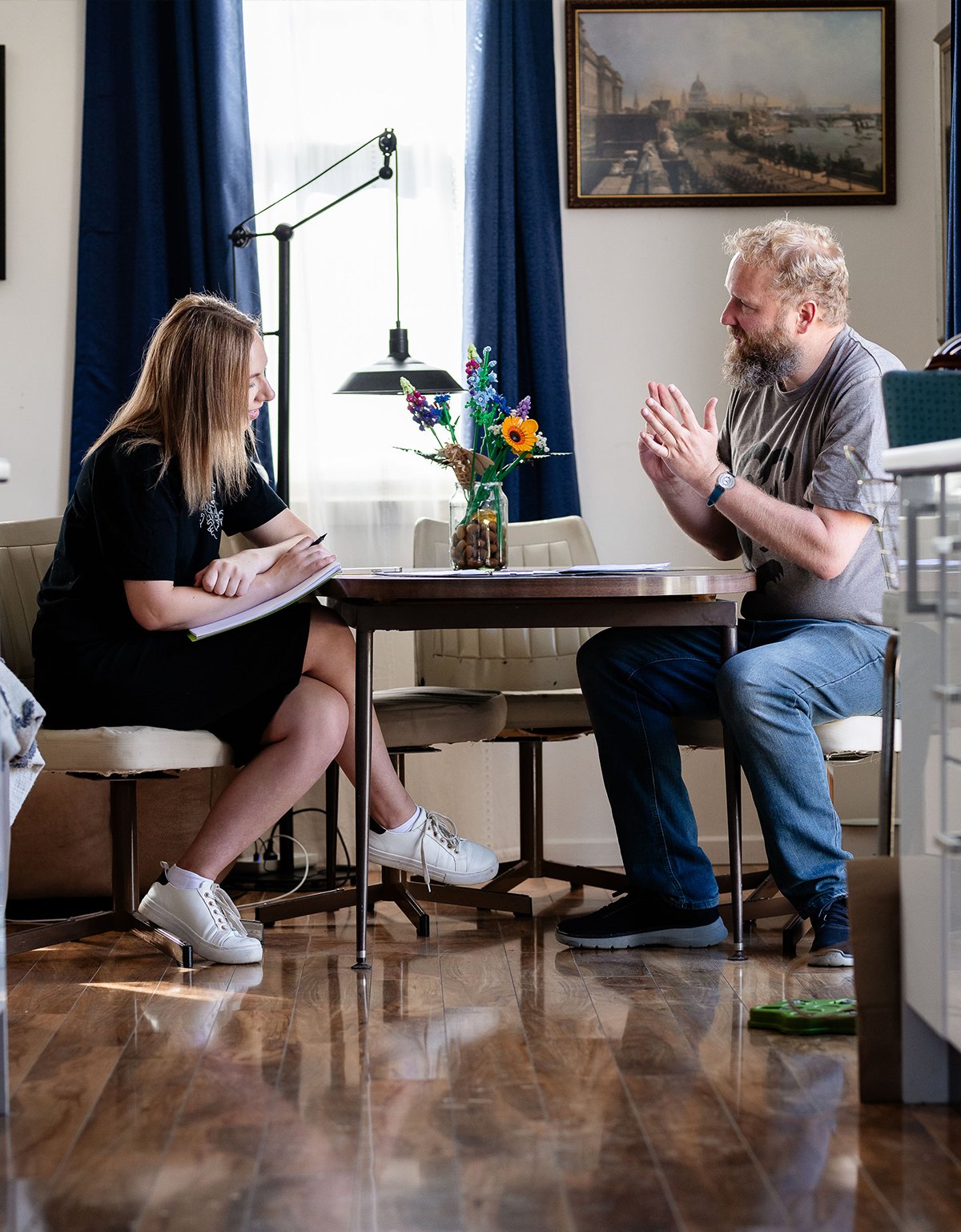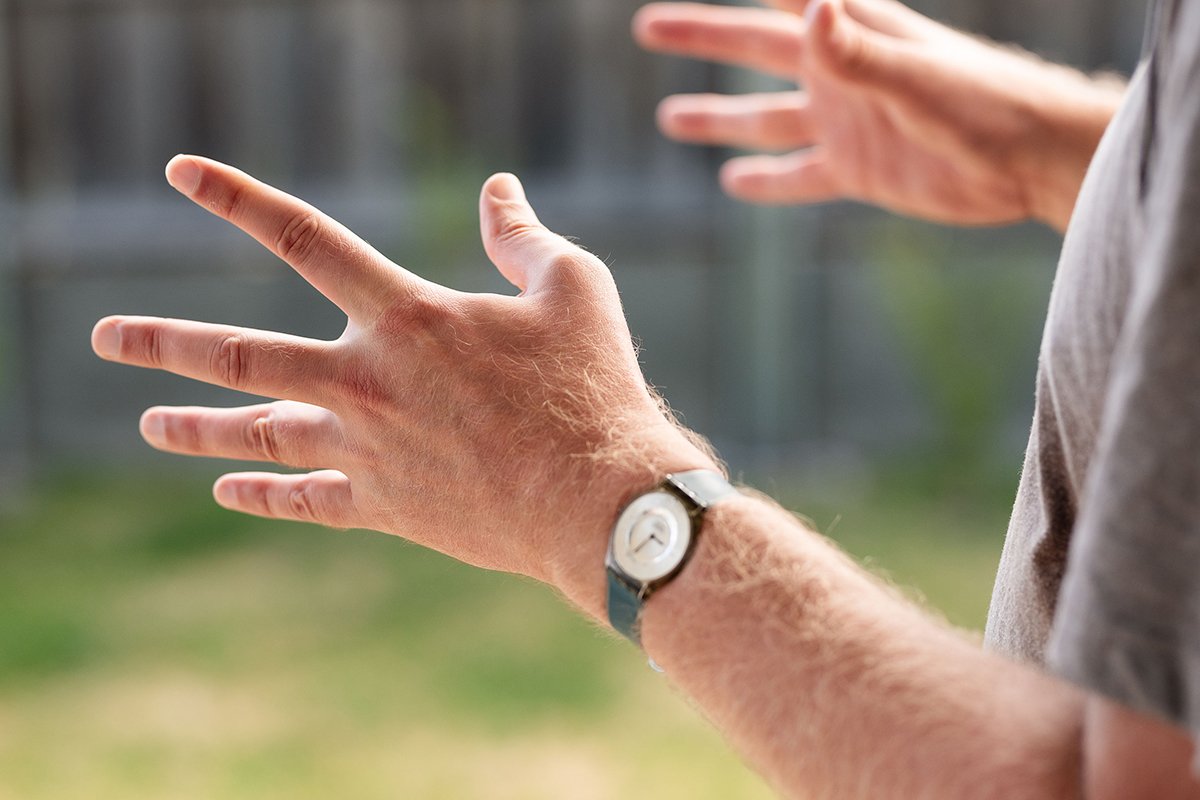Ben Richardson
"If you have a Deaf child, I think it’s important to learn Auslan, for communication as well as culture. Babies can pick up signs from about 10 months. They can pick up sign language before spoken language and can actually ask for what they want."
Ben Richardson grew up with Australian Sign Language – Auslan – as his first language.
His mother is Deaf, and he learned to sign from birth. Ben began interpreting for her from a young age, helping with phone calls, shopping, and meeting people. As a CODA (Child of Deaf Adult), Auslan has always been a big part of his life.
“Auslan is an Australian language,” Ben explains. It has its own grammar, syntax, and slang. “If you try to interpret English language poetry into Auslan, it doesn’t make sense. If you’ve got words like ‘cat’ and ‘hat,’ the English words rhyme, but the signs don’t look anything alike. There’s no rhythm because it’s just an English thing. It’s the same with jokes; they’re always a play on words. You have to explain, ‘This word sounds sort of like that word, and that’s why it’s funny.’”
Signed languages are unique languages that activate the same parts of the brain as spoken languages – which Ben learned from direct experience when he was a teenager.


As a 14-year-old, Ben had a fall that resulted in a traumatic brain injury. He was in a coma for nearly a week. When he regained consciousness, he couldn’t move the left side of his body, and his memories had disappeared. “When I first woke up, I could sign perfectly, because I reverted to my first language, which was sign language. But as soon as I became a bit more conscious, I couldn’t move my left arm. I couldn’t move that side because I was using the movement part of my brain rather than the language part. My mum had to interpret for me. I couldn’t speak English until quite a few weeks afterwards.”
After his injury, Ben spent six months in hospital, and he had to re-learn how to walk. He never regained his earlier memories. He still had many of his pre-injury skills – just no idea how he knew them. He finished school and graduated from uni with Commerce and Arts degrees, majoring in e-commerce and political philosophy. When he finished his degree, he tried a graduate position in the banking industry. “I lasted six weeks!” he recalls, “And I said, ‘this is not for me.’” A friend of his invited him to join her on an Auslan interpreting course. “I sat the exam and got in, and that was 12 years ago now.”
Today, Ben is a professional Auslan interpreter, high school teacher, and stand-up comedian. “I trained in Melbourne, which is an epicentre of Deaf culture in Australia,” he explains. “I got to train with the best, and then I moved to Tasmania.” Ben describes the importance of connecting with the Deaf community in Tasmania. “It’s very personal. You’re interpreting doctor’s appointments, funerals. It takes awhile to build that trust.”

Seven years later, Ben has interpreted for people and events across the state, from guided bushwalks to Mona Foma. “I get to interpret different courses and things – like I’ve done a gravedigging course! I know how to bury people,” he laughs. “It’s never the same job, and COVID has proven what we can do remotely, so now I interpret all around Australia. Deaf people can take an iPad to the doctor’s, university, or a business meeting, and I’ll be there interpreting what’s being said around them.”
Ben talks about the important role of NDIS in providing interpretation opportunities for Deaf people. “It’s been amazing,” he says. “Back in the day, agencies decided what would be interpreted. With the NDIS, Deaf people get their own amount of funding to use for anything they want. I’ve suddenly started interpreting tours of kunanyi / Mt Wellington, and Deaf people love it, because they’ve never had access to these sorts of tours before. They were so excited, asking the tour guide, ‘What’s this?’ and the tour guide will go, ‘You can see the moss eating away at these rocks, this is lichen, this is a certain type of fern…’ They were interested to find out the story. It’s so empowering.”
Four years ago, Ben was considering a career change. He went back to uni to qualify to teach secondary school English and humanities. “But as soon as I started my placements,” he says. “Every school I went to asked me to teach Auslan, because it has just become an option on the curriculum. It’s great because it really engages the students, and it’s an Australian language.”
Now, Ben is one of only a handful of teachers of Deaf students in Tasmania. His role is to visit each Deaf student and provide support in Auslan. “There is very much a Deaf world and a hearing world. Hearing people don’t know that, but Deaf culture is very strong. They have their own ways, their history, their own language,” he explains. Auslan is a living language that has continued to evolve since Ben learned it as a child. “I don’t understand what the kids are saying at all anymore because they’re coming up with new signs for everything all the time,” Ben laughs. “Every day I’m learning new signs.”


Anyone can do it; it comes naturally. You communicate with your whole body, not just your mouth. It’s facial expressions, body movements. Every sign looks like what it represents. If everyone starts signing, everything is more inclusive.
Tasmania has a strong history of Deaf community and culture. “In Tasmania, we had the Claremont Project,” Ben explains. “All the Deaf students went to a single school, which had an interpreter in every class. It was phenomenal, and their model was applied all around Australia. But now there is a philosophy of mainstreaming, which can be very isolating for Deaf children. There’s this idea of integrating them into the hearing community, but it doesn’t work like that. In the end, you’ve got a lot of Deaf kids on their own. Every time I meet a Deaf student, the first thing they’ll say is, “I’m very lonely.” It’s a shame, because if they can learn Auslan and have that community – once they’ve learned their own language, it’s much easier for them to pick up a second language, like English.”
For Ben, teaching Auslan to babies and toddlers is wonderful for both Deaf and hearing children. “If you have a Deaf child, I think it’s important to learn Auslan, for communication as well as culture. Babies can pick up signs from about 10 months. They can pick up sign language before spoken language and can actually ask for what they want. My little nephews, who are both hearing kids, will walk into the room and ask, ‘Where’s mum and dad?’ in Auslan. Anyone can do it; it comes naturally. You communicate with your whole body, not just your mouth. It’s facial expressions, body movements. Every sign looks like what it represents. If everyone starts signing, everything is more inclusive.”
We worked with southern Tasmanian photographer Inside the Frame and southern Tasmanian videographer The Human Story Film for this Tasmanian story.